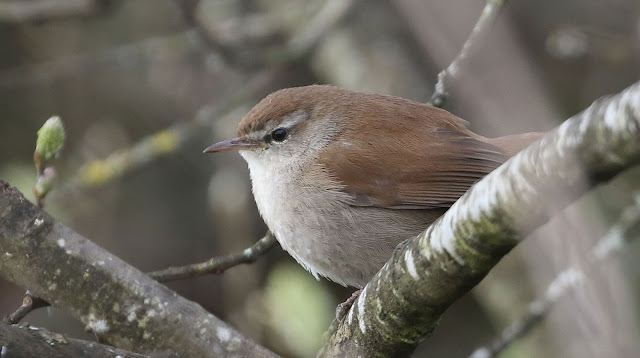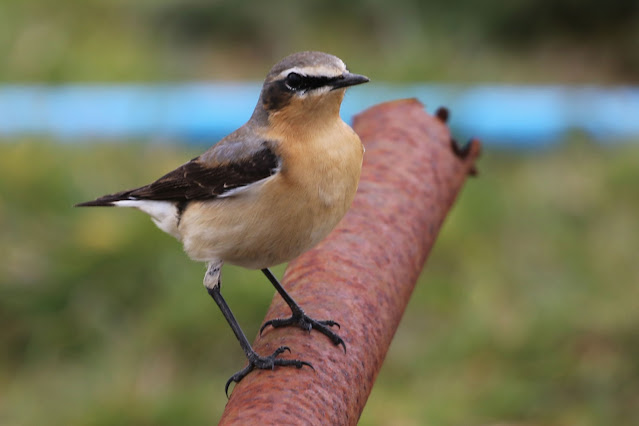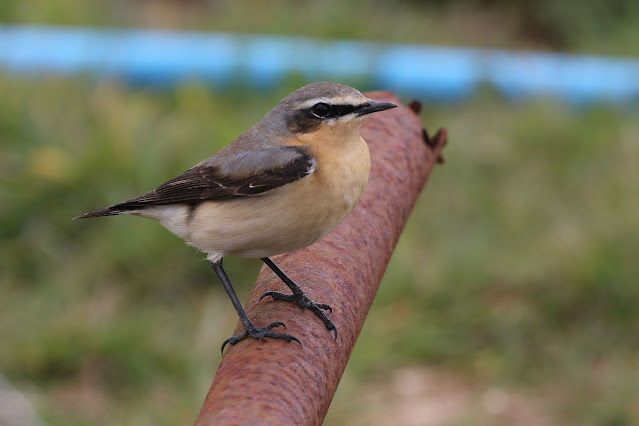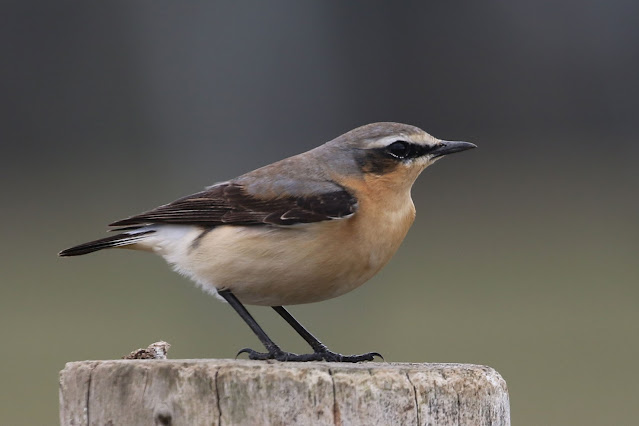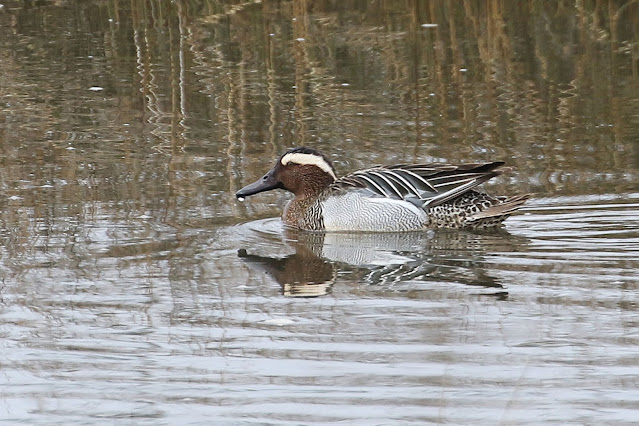The last Saturday of Greenwich Mean Time, the sun was due to rise at around ten minutes before six, but the cloud put paid to that. I arrived at the sea wall with the tide out and a wind blowing from the west. Away across the Solent a rainbow over the Fawley refinery gave away some squally showers that I hoped were heading north, they didn't and I had to shelter back in the car as the shower slipped past. When I finally got out of the car and walked to the beach I was greeted by a small flock of Sanderling flying on to the beach, I resisted.
When the sun finally did break the clouds I was amazed to see how much the sun had moved since the sun rises I had witnessed in the winter. Then it was rising over Portsmouth, today the sun was coming up from behind the reserve visitor centre.
I watched the Brent Geese fly past into the harbour bay and Sanderling were flying back and forth out over the Rainbow Bar and across the beach. One surprise was an Egyptian Goose that flew onto the reserve from off the sea. It was now too clear and I doubted if there would be much moving on the sea, i couldn't even find a Great Crested Grebe.
Over on the scrape the Black-headed Gulls were in full voice and every so often I could hear the bleating calls of Mediterranean Gulls. When Ian arrived we spent some time scanning the sea, but only managed a very distant group of Eider. Finally we walked to the harbour bridge. Here a pair of Great Crested Grebes were displaying but quickly stopped and decided to preen instead. We watched a male Marsh Harrier carrying sticks to a spot in the reed bed, there was not any sign of the female. Mediterranean Gulls could be seen above calling and moving between the sea and the scrape.
We decided to walk the Canal Path. The willow was in bloom and this Greenfinch was singing from the top of one.
As we turned onto the canal path we came across a singing Chiffchaff. This was to be the first of up to eight singing birds along the path.
It is that time of year when the Chiffchaffs are singing and there are no leaves which make it easy to see them and to photograph them as well.
A little further along a male Goldcrest put on a very good show.
A pair of Long-tailed Tits were close by and were probably nest building as they were not in any hurry to move away.
At Hammond's Bridge we had a singing Blackcap, my first for the year, singing that is. But as we searched for them it became clear that there were two males present, keeping quite close to each other. They never showed in the open for a photograph.
There is a light bridge across the canal that leads to farm buildings. There is also a sign that makes it quite clear that this is private property. However it is possible to scan the track leading to the buildings and in the middle of the track was a Water Pipit. Once again a very poor record shot.
On the other side of the buildings were a couple of Roe Deer, this buck looking very relaxed.
Cetti's Warblers are very vocal at this time of year, declaring their territories. This need to be vocal also seem to allow them to let down their natural shyness, and with patience you can get some good views.
The bird is named after the Italian zoologist Francesco Cetti, but he did not discover it, it was described by Temminck from specimens collected in Sardinia in 1820
Here delivering that powerful song. During the summer the males spend most of their time establishing and protecting their territories. While doing this they spend very little time caring for the eggs and young. The males usually attract more than one female to their territories. The song is so essential to the success.
As the Cetti's warbler slipped away into the cover a Stock Dove flew to one of the branches of a dead tree above us. It has been a really good year so far for seeing this delightful dove
Approaching Posbrook Floods the trees were looking special in the sunshine.
The floods were busy with Black-headed and Mediterranean Gulls while on the edges was a large flock of Black-tailed Godwits and amongst the rushes there were Teal, Shoveler, Gadwall, Wigeon and Pintail. However there was no sign of the hoped for Sand Martin.
We walked on and climbed the gate to check the horse field after the bridge. Here we hoped for maybe a Wheatear, which wasn't to be, but we did find up to six Sand Martin. The split tree was empty with a pair of Stock Dove daring to check out the residence. A Peregrine put all the birds on the river floods up but didn't seem interested and continued up the valley
Walking back we decided to walk around the floods. The path here is still flooded but passable in our wellies. In doing so we disturbed the Black-tailed Godwits, that took off, split up and some headed south across the reeds.
We returned to the Canal Path and came across a couple who were watching a very confiding Treecreeper.
The walk back contained pretty more of the same as the walk up, singing Chiffchaff and Cetti's Warblers, Great and Blue Tits and a couple of Wrens. We also had a very interesting chat with a guy responsible for monitoring the Water Voles and other animals, including Otters along the canal.
A report of a Wheatear in the large field close to the thatched house proved to be a fruitless search, it probably hiding in the tractor ruts. Back at the cars, as we ate our lunch a Peregrine was seen to send everything up on the scrape and flew off with what looked like a Lapwing.
After lunch we decided to drive around to Warsash, parking at the sub station. We walked to the TLC horse field where both Wheatear and Little Ringed Plover had been reported. Walking along the path and looking over the fields there were areas that were partially flooded, Pied Wagtail and Meadow Pipits could be heard. Scanning the pools I found the Little Ringed Plover, there were two, but very distant once again.
We left the plovers and walked to the area to the north of the fields, there were a couple of birders present so we were confident the Wheatear were there. As we got closer we could pick out all three, still distant though. This was the closest.
We settled in to watch the Wheatear. One bird was showing a lot of orange on the breast and stood out in the grass. As I watched it took flight and headed towards us, it just kept coming and finally settled on some old posts about ten feet in front of us. I couldn't believe it some great views.
Whilst it stayed in the same place it did change positions, slightly
Then it flew, but fortunately to the post on the fence with a slightly better background.
Then it was off, flying across the main path and in to a distant field.
Across the field a Peregrine was heard calling and could be seen perched on the pylon where we were informed a pair appear to have taken over an old Raven nest. The Peregrine then flew off still calling and headed away over the trees.
We were told that you could get a better view of the Little Ringed Plover from a bank close to Workman's Lane. When we got there we didn't feel it was any closer, the plover still appeared distant. The Little Ringed Plover then flew off together and dropped into another pool and out of view. We walked around the housing estate with nothing of interest. We did though come across a Blackbird that was calling in alarm, the reason, a Magpie with a very young fledgling, no doubt the nest will soon be cleared out now they know it is there.
Back at the bank the Little Ringed Plover were back on the pool, maybe a little closer.
That was the end of the day, but on the way home I decided to follow up on a report of Little Owl at Cheriton Mill, just to the south of Tichbourne. The tree was very obvious, but there was no sign of the Little Owl, then I heard one calling from within some scrub close by. I saw some movement but nothing acceptable. I will have to come back I am sure they will show.
A completely different day to last week, but some great views of Cetti's Warbler and Wheatear and three more year ticks.
















